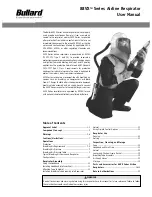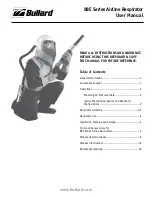
UNPACKING AND INSPECTION
DO NOT charge the battery pack where there are
explosive concentrations of combustible gases,
vapors, or mists. An explosion or fire can result.
Replace the charger if the cord is damaged or worn,
or if the case is cracked or distorted. Do not use a
damaged charger. Doing so can result in serious per-
sonal injury or death, or create a fire hazard.
2. Charging the battery pack
a. Push the charging
plug into the charg-
ing jack. Be sure that
the plug is all the
way in.
Note:
To use the dual-rate charger, insert the charging
plug in the charging jack as usual. Then insert the male
control plug into the center jack in the battery pack.
b. Plug the charger into a 115-120V, 60 Hz (standard
AC) outlet.
Voltages lower than 110V are not recommended.
Voltages greater than 120V will damage the battery
charger and battery pack. Limit the charging time to
24 hours maximum with the standard charger. Timer-
controlled outlets may be used. Do not charge the
battery pack for more than 24 hours with the standard
charger. Over-charging seriously reduces battery life,
and could create an explosion hazard, resulting in
serious personal injury or death.
c. Charge the battery pack a minimum of 16 hours (8
hours for dual-rate).
Note:
Do not charge partially-discharged battery packs at
the full-charge rate, which increases temperature substan-
tially. Repeated charging in this manner reduces service
life. If the standard charger is used, charge at 200% of
pack use-time (e.g., a pack used 2 hours is charged 4
hours). Charging based on use time returns the pack to
full capacity without increasing temperature. If this
method is not practical, use the dual-rate charger.
d. The battery pack can be stored for long periods at
room temperature. However, several cycles (charg-
ing followed by discharge) may be needed to
restore the pack to full capacity. If the pack has
been stored in a "charge-ready" condition, it should
be charged for 6 hours every 30 days to maintain a
capacity of 70% or greater.
e. The standard charger uses a one light emitting
diode (LED). The LED shows that proper voltage is
present. The chart below shows how to "read"
charger and battery performance for the dual-rate
charger (P/N 486614).
*Allow at least 20 minutes for the light to come on if you
are charging a severely-discharged battery pack.
3. Re-attaching the battery pack
a. Line up the dovetail
on the battery pack
with the dovetail on
the motor-blower.
b. Slide the battery pack and the motor-blower togeth-
er until the spring clip snaps into place.
c. Check for gaskets in the filter or chemical cartridge
receptacles and re-install the cartridges.
LITHIUM BATTERY PACKS
Lithium Battery Packs maintain over 85% of their original
charge for up to 10 years. This battery pack is a single-
use battery which will last for a shift under normal condi-
tions. When the pack reaches the end of its life, dispose
of it according to appropriate disposal procedures.
DO NOT recharge a Lithium Battery. The Lithium
Battery can explode. Failure to follow this warning can
result in serious personal injury or death.
ASSEMBLING THE SUPPORT BELT TO THE MOTOR-
BLOWER
Slip the support belt through the belt loop on the motor-
blower.
8
TAL 804 (L) Rev. 17 - 490883
Voltage
Current
Indication
ON*
ON
Good pack; accepting charge.
OFF
ON
Bad pack; current flowing but low battery
voltage; replace pack.
ON
OFF
Open circuit or bad pack; check that
charging plug is clean and fully inserted in
jack; internal battery open circuit; return bat-
tery pack to MSA.
OFF
OFF
No power or bad pack; check that charger
is plugged in (120 VAC); check cable to
battery-pack.
WARNING
WARNING
WARNING
Summary of Contents for OptimAir 6A
Page 12: ...NOTES 12 TAL 804 L Rev 17 490883...
Page 18: ...NOTES 18 TAL 804 L Rev 17 490883...
Page 20: ...NOTES 20 TAL 804 L Rev 17 490883...
Page 30: ...OPTIMAIR 6A PAPR WITH COMFO ELITE FACEPIECE 30 TAL 804 L Rev 17 490883...
Page 37: ...20 37 TAL 804 L Rev 17 490883...
Page 38: ...NOTES 38 TAL 804 L Rev 17 490883...








































